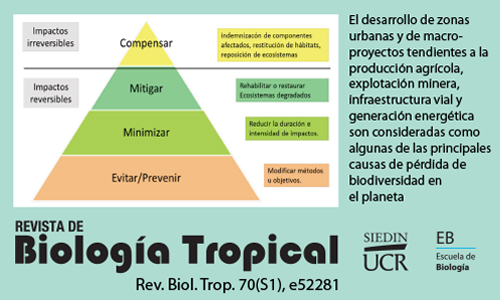Resumen
Introducción: La generación de impactos negativos producto de proyectos de infraestructura o actividades de desarrollo generan pérdida de biodiversidad y reducción de la calidad de los servicios que el ambiente provee a sociedades humanas. Afortunadamente, muchos de esos impactos pueden ser reducidos, controlados o resarcidos por medio de medidas de mitigación, rehabilitación y compensación, que suelen sustentarse en el marco jurídico ambiental de los países o estados donde son implementados. Esta revisión provee una visión teórica del uso de compensación ambiental como instrumento jurídico/técnico integrado al manejo del entorno natural.
Metodología: Realizamos una revisión de la literatura global sobre el tema mediante los buscadores de referencias GoogleScholar y SciELO empleando varios indicadores en inglés y español.
Resultados: Un total de 244 referencias sobre compensación ambiental fueron encontradas, catalogadas y evaluadas, mostrándose un claro patrón de incremento del número de ellas en la última década. La compensación ambiental constituye un instrumento jurídico/técnico que permite resarcir por pérdidas ambientales y suele ser un componente de los Estudios de Impacto Ambiental regulado por el estado. Varias estrategias metodológicas son empleadas para establecer acciones compensatorias, cada una de ellas sustentada en alguno de cuatro enfoques posibles: económico, ecológico, político y cultural/social. Dentro del enfoque ecológico, se busca la equivalencia ecológica entre los elementos ambientales impactados y la compensación, procurando que no exista pérdida neta. Así, este enfoque tiene la ventaja de posibilitar la incorporación de múltiples criterios para la evaluación del daño y de las acciones de indemnización, por lo que es posible de aplicar en situaciones diversas. A pesar de su uso, la aplicación de medidas compensatorias no está exenta de crítica y hay situaciones en que la singularidad de los elementos impactados imposibilita un resarcimiento efectivo de las pérdidas.
Conclusiones: La compensación tiene gran relevancia actualmente en la gestión ambiental y debe favorecer el derecho universal a un ambiente sano. Sin embargo, su aplicación efectiva requiere claridad en los procedimientos seguidos y una muy estrecha vigilancia prevenir pérdidas o incluso una ganancia neta ambiental.



